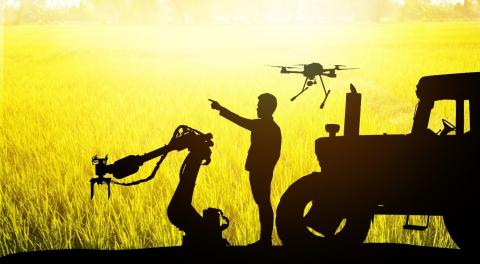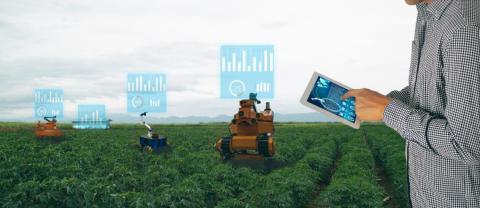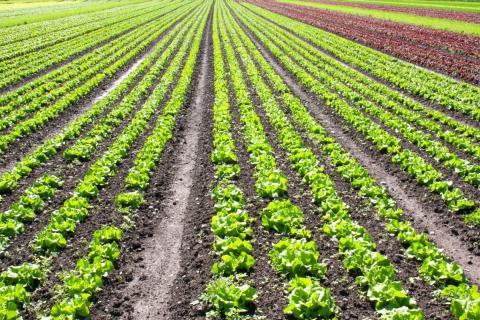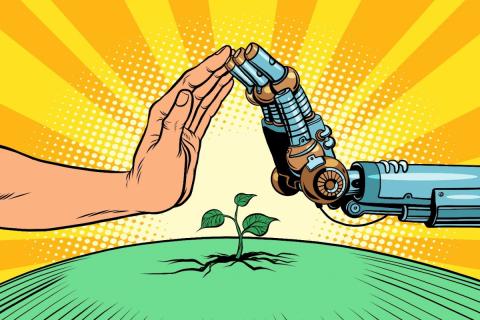26 June 2019
Dr Peter Wootton-Beard RNutr: IBERS, Aberystwyth University.
- Robotic weeders aim to increase both the precision and automation of weed control through either chemical or mechanical methods, within rows.
- Most rely on rapidly improving vision tools and image analysis to either selectively target weeds, or to selectively avoid crops.
- Robotic weeders cope well with precision plantings, but are as yet, unable to cope effectively with the ‘surprises’ presented by many real-life scenarios.
The wrong plant in the wrong place earns itself the mantle of ‘a weed’. Anything other than the target crop may compete with it for light, water and nutrients, reducing the potential harvest. Many weed species are highly adapted to take advantage of short windows of opportunity. Through rapid growth and reproductive cycles, they are far better adapted than the delicate, mollycoddled, but nevertheless precious edible crops that producers want to grow. The advantage therefore, must be afforded to the underdog, and therefore every horticultural producer does their best to stack the decks in its favour through either chemical, mechanical or manual weed control measures. The weeds have accepted that they may lose a battle, but in true Hollywood style, they intend to win the war. Increasing levels of herbicide resistance are being reported, alongside a reduction in the number of herbicides considered safe to use, particularly for organic production. Couple this with a scarcity of manual labour and an increase in its cost, and the scene is set for the weeds to triumph. There are environmental and social benefits to these changes, but crops still need to be grown, and producers still need to make a living, so new methods of weed control are required.
The key targets for innovation in weed control are improvements in precision, to limit the health impacts of chemical control, and increased automation, to reduce reliance on manual labour. Robotic weeders are one such innovation, and this article aims to describe the ways that they operate, as well as providing practical, technical guidance as to how they can be used by producers, both now and in the future.
Robotic weeders are currently labour saving devices which are operated at the direction of a supervisor
Methods of operation
Robotic weeders come in a range of shapes and sizes, but in general they can be divided into those which deliver chemical herbicides and those which automate traditional processes of mechanical weeding such as hoeing.
The first type of ‘robots’ are those which are still manually operated, and designed to reduce the amount of labour required and change the mode of that labour from the physical task of removing weeds by hand, to the more efficient method of directing a machine to do so. They can be thought of in the same manner as tractors, or combine harvesters – as labour saving devices. Many are self-guiding using simple odometry sensors or GPS technology, requiring only adjustment to the desired route, or factors such as how much herbicide to apply, or how vigorously a mechanical hoe operates. Such devices may not deserve the title of robot, since they do not act without human intervention, a characteristic which commonly defines a ‘true’ robot.
Weeders such as Lettuce Bot (Blue River Technology), now well established in the US, are pulled over the top of a vegetable crop by a tractor, and utilises computer vision equipment to compare an image of every plant encountered with an extensive database of control images. Upon detecting an unwanted plant, the machine delivers a precise application of concentrated fertiliser (or herbicide if desired), killing the weed but enriching the nutrient content of the soil for the surrounding crop.
There are equivalent mechanical systems such as Robovator (F. Poulsen Engineering), which use the same computer vision technology to avoid the crop, whilst deploying tools to disturb the soil. In such machines, planting plans can be pre-loaded and the tool used to deliver the weeding action can vary from a mechanical hoe to a thermal weeding tool utilising a pinpoint flame or heated oil, a targeted laser device or a combination of tools for different areas of soil.
These robots are considered to reduce the labour requirement for weeding by a factor of 10. They operate at 2-4 mph and may cost somewhere between £100,000 and £200,000 to buy, depending on their specifications. Their computer vision tools can be combined with seed/seedling mapping, and allow them to remove weeds closer to the crop.
A new range of bots, such as Ecorobotix (Ecorobotix Ltd.), take similar tools but remove the need for manual control, instead adding a wider range of sensors, and automating the process using complementary technologies such as solar power. Much like solar-powered lawn mowers, these machines are able to be programmed with a route to follow or guide by remote technologies, given a schedule to operate upon, and then left to complete the task unaided.
Technologies
Evaluating the potential to use a robotic weeder in any given production system, requires a robust understanding of the technology it utilises, its potential benefits, and its limitations. A range of technological solutions to automation in agriculture are tested as part of the Hands-Free Hectare, an innovative test case for future production methods.
Where it goes
The first level of technology is that which decides where the robot can go. For labour saving devices, that may be as simple as following the tractor to which it is attached. However, at the next level of automation, robots acting independently can be guided by real time kinematic global position systems (RTK-GPS), which use satellite navigation techniques (an advance on a car’s ‘Sat. Nav.’). There are examples of weeders using these systems such as DINO (Naȉo Technologies). The system allows the robot to act without supervision, assuming that an accurate map of the area is available. These systems can be coupled with seed/seedling geo-referencing, which allows the robot to be guided by the position in which the seeds were originally sown. This relies on precision sowing and the ability to store and retain accurate records.
What it ‘knows’
The ability to refine the application of robotic weeding depends on how much information is available upon which to base decisions. Robots commonly contain a multitude of remote sensors, collecting information on environmental factors such as meteorology, soil parameters, and on-board activities. The accuracy of this information, its interpretation, and the ability to record it, each contribute to informed decision making, either by a person controlling the use of a robotic weeder, or in the future by the robot itself, either responding to changes or applying situation specific settings. The sensors can also be used to monitor general information about the production operation which, even if they are not used to directly adjust the performance of the robot, can still be informative at a farm business level.
How it ‘sees’
The robot needs to be able to differentiate between a weed and a crop plant. This is the basic difference between a simple tractor mounted between-row weeder, and a precision robot capable of weeding within rows. Plant identification relies on the ability to assess biological morphology, spectral characteristics (colour/reflectance) and texture. The use of biological morphology relies on shape recognition, and the fact that each species has a unique shape, something which is particularly challenging for crops which are closely related to weed species. Advances on these technologies include a transition from 2D to 3D cameras, multispectral imaging and plant identification libraries containing many thousands of images of crops and weeds from every conceivable angle to act as a reference point.
How it acts
Once a weed is detected, the robot must take action. The way it does this has an impact upon its capacity and accuracy. If it is applying a chemical treatment, it must be able to do so selectively and accurately using advanced micro-spraying technologies and highly accurate spray nozzles. This not only ensures satisfactory weed removal but also contributes to the environmental benefit of using a robot. If the action delivered is mechanical in nature then the type of tool, and its sensitivity are the critical factors. A range of precision tools are utilised on robotic weeders including hoes, finger tines, oscillating discs and cutters. There are also examples of other precision tools applying flames, freezing, lasers, air blasts and even 160°C heated food grade oil to kill weeds.
What it needs
In order to operate, a robot needs a power source, and a maintenance regime. Robotic weeders can be operated by being towed, but there are also examples with diesel engines, battery power (chargeable) and on-board energy generation through solar panels. The source of power may determine somewhat, the ability of the robot to act autonomously, but also the need for a fuel source and the associated costs. The ability of the robot to detect problems such as blockages, and fix them will also impact upon autonomy, whilst the requirement for maintenance may result in labour costs which are removed from the field, being reapplied in the farm yard.
If it learns
The critical ability, which could lead to genuine labour free weeding, is the ability of a robot to not only measure and record information, but to act upon it, and potentially, to actively learn from experiences to improve performance. At present, this factor is reduced to the ‘intelligence’ level of the robot, i.e. its ability to make decisions based on the information it receives rather than to rely on the direction of a human supervisor. This could include elements such as an ability to detect its own inefficiency and repeat an action, rather than relying on follow-up manual labour, or to pause activity during a heavy rain shower.
Decision making, and autonomy depend upon the information collected from the field.
Practical considerations
If only the task at hand, namely weeding a row of vegetables is considered (without any social bias) then the main disadvantage of a robot is its inability to be reactive to complex and highly variable environments that are typical of real-life production systems. Whereas a human can alter their activity to suit the imprecise nature of fields which are not square, flat, or necessarily precision planted, a robot cannot, at present, make such adjustments. This limits their application to row crops, which are precisely planted, and prevents their effective use on broadacre crops, closed canopies or on land which undulates. The limitations of using such a system, in a Welsh small-scale horticultural context are currently being investigated.
There are limits too, to the use of certain technologies. Computer vision works well on a clean, green leaf, but it cannot make an accurate determination if the leaf is dirty for example. The accuracy of differentiation between weed and crop is also technically challenging, particularly at the seedling stage, which means a loss is expected for mistakes, or inadvertent damage caused by imprecise application of mechanical tools. In these scenarios there are fine margins of error, particularly at relatively high speeds. Where there is even spacing and predictability, the robot can cope, but any deviation from that creates the possibility of accidental crop damage, or the need to repeat the process by hand.
If a robot applies a chemical treatment, it too is limited by the availability and regulation of effective chemicals. Whilst it may offer environmental benefits through the precise application of a given chemical, it could still fall foul of changes in regulations or policy which prevent their use. Furthermore, specific crops may have a limited range of approved treatments (e.g. spinach) which may limit the ability of a producer to use the same robot for multiple crop types.
Producers must also evaluate the economic case for using a robotic system. Whilst the pressures outlined in this article apply universally, there is still no guarantee that a robot would prove more cost effective than hand weeding, or that the need for labour would be eliminated. A comparative study of labour requirements between hand hoeing and robotic hoeing reported that the average number of person hours needed to weed 100 m2 was 0.241. Once the robot had passed, the number of ‘follow-up’ person hours needed to render the plot completely weed free was 0.102, a reduction of 57.5%. This highlights the fact that a robot does not necessarily replace labour, but may simply reduce it, and although this figure would improve with each pass of the robot over the same row, it may not be able to achieve the same efficiency as a person. The cost of the equipment must also be factored in, for example the previously featured ‘Robovator’ could cost £100,000 to buy and around £213 per Ha to operate. Whilst the operation cost may be roughly a tenth of the cost of hand weeding the same area, the costs associated with purchase, maintenance and depreciation are additive, and unique to the robot.
The factors which are unique to the specific farm business are perhaps the most important considerations. Robots cope best with well-established stands, low weed densities, and crops which are larger than the weeds. Any deviation from this ideal scenario is likely to make operations less efficient, and either require more equipment (and therefore cost) or more follow-up labour. Robots are also, most effective before weeds become established, and early interventions are considered crucial for a high degree of success. Meeting these specifications may mean that, for the time being, robots are best suited to speciality crops, such as asparagus or lettuce. Research has also highlighted the importance of intelligence in the robotic system (the ability to accurately detect the weed and/or the crop), essentially this means that the more equipment the robot has, the closer it can get to the crop, and the more effective it can be. This indicates a diminishing return with simpler, less costly technologies. The operation and programming of robotic systems requires fewer human hours, but the ones it does need require a high degree of technical competence, skills which are currently in short supply.
Robotic weeders cope best with precision planted crops, on land which has consistent characteristics
Future opportunities
The future of robotic agriculture rests upon the ability to produce ‘true’ robots, machines that are entirely independent of human control. This transition from processes which are more automated to processes that are fully automated will typify the evolution from what is referred to in the literature as agriculture 4.0 to agriculture 5.0. The key technological advancement that would enable this to become a reality is the development of genuine artificial intelligence – the ability for a robot to learn. In a recent publication, a weeding robot was considered truly robotic if it met the following criteria:
1) It had the ability to monitor the crop, weeds, weather and soil in real time.
2) It could decide when the crop needed to be weeded.
3) It could choose the optimal weeding implement.
4) It could take the weeder to the field that needed to be weeded.
5) It could adjust the chosen implement for optimum performance.
6) It could monitor itself for blockages and mechanical problems, and fix them.
7) It could continually monitor and adjust performance in the field.
8) It could return the weeder to the farm once the task was complete.
9) It could clean, maintain and store the weeder.
This list simply seeks to highlight the difference between a labour saving device, and something truly robotic, and that there is a large difference between them. However, most of the technology required to achieve this already exists, particularly in terms of remote sensing. With the ability to ‘learn’ and apply that learning to variable contexts, robotic systems may well be able to replace labour to a much higher degree than is currently possible.
Near market improvements in robotic weeding include improved weed/crop differentiation through rapid advances in image analysis techniques and the potential for crop tagging. Alongside this are improvements in precision instruments, able to get closer to the crop, with minimal disturbance and damage. Robots also have the potential to be quickly updated though software, which can make them more responsive to changes in technology and trends for data driven decision making brought about by the advent of the internet of things.
Skills training, policy making and regulatory mechanisms need to keep pace with the capabilities of technology for them to be efficiently utilised. The most commonly quoted milestone for the predication of human activity, particularly in terms of agricultural output is 2050. Any consideration of weed management in 2050 will need to be able to take the early promise of today’s robotic labour saving devices and apply them to the most complex production systems as well as the most extensive. It has recently been reported that an entirely different approach would be required for broadacre crops, and to achieve truly sustainable intensification, that is the field on which the robots must next do battle.
Summary
Robotic weeders exist, which are both efficient in terms of their ability to complete the task of weeding, and also cost effective compared with the manual alternative. However, they are best utilised where conditions are highly predictable, namely on well-established stands, which are precision planted, have low weed densities and where the crop is larger than the weed. The level of technology currently available precludes their effective use in ‘irregular’ production scenarios where the robot may encounter a ‘surprise’ which it hadn’t expected (e.g. change in angle, soil conditions, row spacing, etc.). This makes their use in many real-life horticultural settings challenging. Trials are underway to provide information of these factors, and how to mitigate them for small scale producers. In order to become truly robotic and replace human labour, weeders will need to be able to process a wide range of data, make effective decisions, and learn from their in-field experience.




